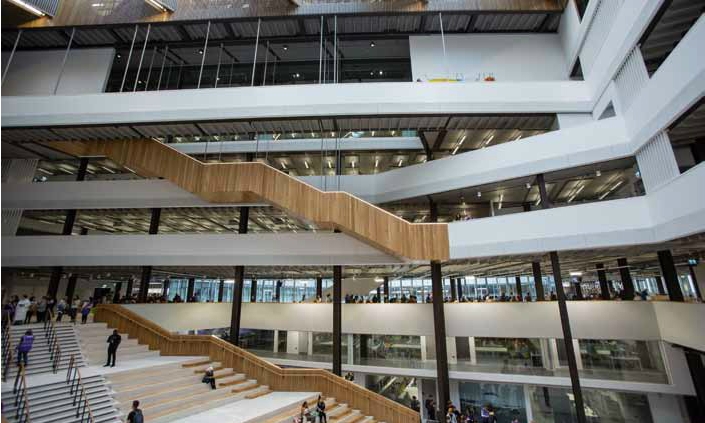GLASGOW was named European City of Culture in 1990 and now, over 25 years after the accolade catapulted it into the cultural limelight, the vibrant city continues to impress with a focus on the arts and education.
You don’t mess with the skyline, or riverfront view, of such a historic city lightly. Situated in the heart of the city and on the banks of the River Clyde, the bold new twin-site, City of Glasgow College super campus, imbued with Glasgow’s energy and complexity, is impressive. A host of design awards for Michael Laird and Reiach and Hall Architects, supported by Arup Acoustics, is testament to this. Riverside campus has already picked up the RICS Award: Design through Innovation; RIAS Award; RIBA National Award and the Scottish Design Awards for Best Public Building.
The £228m twin-site super campus itself constitutes a city community, a so-called “sticky” campus, with all the desirable amenities necessary to keep students on-site and engaged. It is therefore no surprise that it is now Scotland’s number one destination for HE students. The design and elevated position shouts aspiration and learning. However, unlike some other cloistered, tucked away institutions, it welcomes the community, especially via its student run shops, cafés and restaurant.
City campus on Glasgow’s Cathedral Street is the final phase in the realisation of a super-college which has brought together accommodation from eleven separate buildings. At over 60,000m2, it has over 500 high‐tech learning spaces as well as a multi‐purpose lecture theatre. Specialist facilities include: a multi-discipline construction hall; state of the art computer suites; competition standard sports facilities and a faculty of creative Industries with panoramic views of the city. A full aircraft cabin facilitates cabin crew training. In addition to these the building incorporates a suite of media facilities including Scotland’s second largest TV broadcasting studio and industry standard radio production facilities.
Walking into the building, you find yourself in a vast atrium, large enough to swing the natural history museum’s famous diplodocus. A wide and inviting staircase, dotted with seated, chatting students, encourages you further into the light and airy environment. But, take note; this is where so many designs have fallen at the first hurdle. A plethora of recent F&HE buildings, also of impressive aesthetics, have failed to address the one essential design element that is invisible, but essential to the learning process– acoustics. An atrium of this scale, with so many concrete, reflective surfaces has the potential to create an environment of such noisy proportions that you would, as the saying goes, find it hard to hear yourself think. That kind of noise drives students off campus and spills over into learning spaces, making for high background noise levels and poor speech intelligibility.
Noise, unwanted sound energy, is controlled by absorption. There is a standard for the acoustic design of learning environments, Building Bulletin 93 (BB93), part of the Building Regulations E4 in England and Wales. This formed a vital part of the design brief. The thermal strategy for the campus requires exposed concrete soffits; a traditional acoustic suspended ceiling was, therefore, not a solution in this instance. Instead, the architects chose a combined acoustic solution to achieve an optimal learning environment: vertical baffles, horizontal rafts and wall panels in slate grey, by Swedish manufacturer, Ecophon.
“The accurate predicted reverberation time of an extremely large atrium and a number of varying teaching spaces was crucial in achieving a successful design,” says Luke Robertson of acoustic consultants, Arup. He compared the results of multiple calculation methods to improve certainty of success. Their Absorption coefficient data from Arup’s extensive library of both laboratory and in-situ commissioning measurements, along with Ecophon data, was drawn upon; optimal positioning of the acoustic baffles, rafts and wall panels was developed with the Architect to ensure maximum absorption efficiency. The use of their auralisation suite, SoundLab, where they can simulate the buildings acoustic signature, before ground is even broken, was extremely useful. Both the architects and faculty were able to determine which areas needed screening and which could be left open, particularly areas off of the atrium.
Although BB93 is not mandatory in Scotland, as it is in England and Wales, it was utilised within the brief. Don Oeters of Arup Acoustics explains recent changes, some of which he wrote. “Criteria for sound insulation, internal ambient noise and reverberation control are similar to BB93 (2003). BB93 (2015) addresses some compliance issues including cross-ventilation from classrooms to circulation and specification of sound absorbing finishes to sports halls and gyms. There are now defined criteria for ‘Alternative Performance Standards’ and refurbished rooms. Other changes include the introduction of recommended noise limits from equipment such as projectors or fume cupboards, which are described in more detail in the Association of Noise Consultants online publication Acoustics of Schools: a design guide. Also, new standards, in line with the Equalities Act, now take into account students with a more broadly defined range of language and communication difficulties.”
Early testing of mock-up rooms was organised to verify the predictions. The result was a close correlation between predicted and measured results; a successful design and a happy client.
By Shane Cryer, Concept developer – Education, Saint-Gobain Ecophon
If you would like to participate in a future case study visit of this campus, please contact: This email address is being protected from spambots. You need JavaScript enabled to view it. Mobile: 07771 565370


